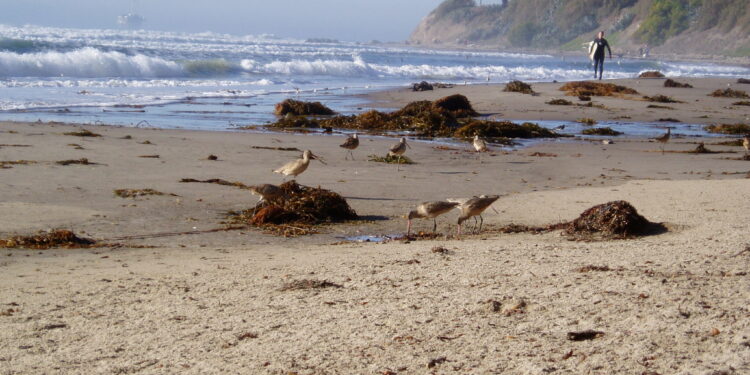Shorebirds feed on kelp on a California beach. Credit: Jenny Dugan, UC Santa Barbara
The Santa Barbara Channel’s kelp forests and sandy beaches are intertwined. Giant kelp, the foundation species of rocky reefs, is an important part of the beach food web because the fronds of these giant algae break off from the forest and are transported to the beach. But the relationship is deeper.
In an article published this week in the Proceedings of the National Academy of Sciences, a team of scientists has demonstrated that kelp forests can do more than provide food for tiny, hungry crustaceans living in the sand. They can also influence the dynamics of the sandy beach food web.
“The amount of kelp on the reef changes over time, such that the peaks and low points of abundance in multiple kelp forests correspond,” said lead author Jonathan Walter, a senior researcher at the University of California, Davis, and its Watershed Science Center. “This is what we call synchrony. It is related to the ability of systems to persist in the face of changing environmental conditions. A little asynchrony allows systems to be resistant to fluctuations and therefore more stable.”
The study reveals the role of synchrony in the beach food web, with broader implications as climate evolves in ways that could alter how linked ecosystems perform their functions.
Revealing the role of synchrony in these ecosystems fills a key gap in our understanding of the reef-beach connection.
“The kelp forest and the beach are both very dynamic ecosystems,” said co-author Jenny Dugan, a coastal marine ecologist at UC Santa Barbara. “The key question here is how the dynamics of these two ecosystems interact and behave, particularly with the beach system so dependent on kelp forest.”
In sync
Although a natural and ubiquitous phenomenon, synchrony and its implications are not yet fully understood.
The research team sought to understand if and how kelp debris (litter) might affect the dynamics of the beach ecosystem. For example, how might species respond to a changing environment and how resilient is the beach ecosystem to disturbance?
Kelp forests and the beach are very dynamic and interconnected ecosystems. Here, kelp drifts on the ocean surface near Santa Barbara. Credit: Kyle Emery, UC Santa Barbara
To answer these questions, the study used long-term data from UCSB’s Santa Barbara Coastal Long-Term Ecological Research Site, supported by the National Science Foundation. The team’s model was built on a time series of wind, wave, wreck and beach width data from five sandy beaches over 11 years.
It revealed patterns of synchrony, in which the abundance of kelp on beaches could be explained by the abundance of kelp in the forest, with wave action and beach width fluctuating together. At the longest timescales, kelp forest biomass and beach width were the main factors responsible for the presence of kelp on beaches.
Beach melodies
“We saw significant time lags in this synchronization,” Dugan said. “It wasn’t as simple as everything changing at once: it was like separate songs or melodies coming together in different ways. This made the patterns more complex, which is why it required the type of analyzes that we used.”
Importantly, the researchers found that this synchrony extended from the ocean to the shore. The abundance of predatory shorebirds, such as sandpipers and plovers, lagged behind the deposition of wrack on beaches.
“Once on the beach, the kelp supports a very productive community of small invertebrates – crustaceans and insects – which are in turn the preferred food of shorebirds,” Dugan explained. The synchronization between the systems is particularly notable because the beach ecosystem relies heavily on kelp subsidies, she added.
Dynamic character
“The dynamic nature of kelp forests, in terms of high productivity and turnover, is unique for ecosystems structured around foundational species,” said co-author and coastal ecologist Kyle Emery, a researcher at the Institute of Science UCSB Marines.
“This allows us to observe changes multiple times compared to other fundamental species and gives us the ability to observe many different states, processes and functions of the system. This has allowed us to more quickly analyze these questions of synchronization between ecosystems.”
More information:
Jonathan A. Walter et al, Spatial synchrony spreads across ecosystem boundaries and along food webs via resource subsidies, Proceedings of the National Academy of Sciences (2024). DOI: 10.1073/pnas.2310052120
Quote: Study reveals synchrony linking kelp forests to the beach (January 3, 2024) retrieved January 4, 2024 from
This document is subject to copyright. Except for fair use for private study or research purposes, no part may be reproduced without written permission. The content is provided for information only.



